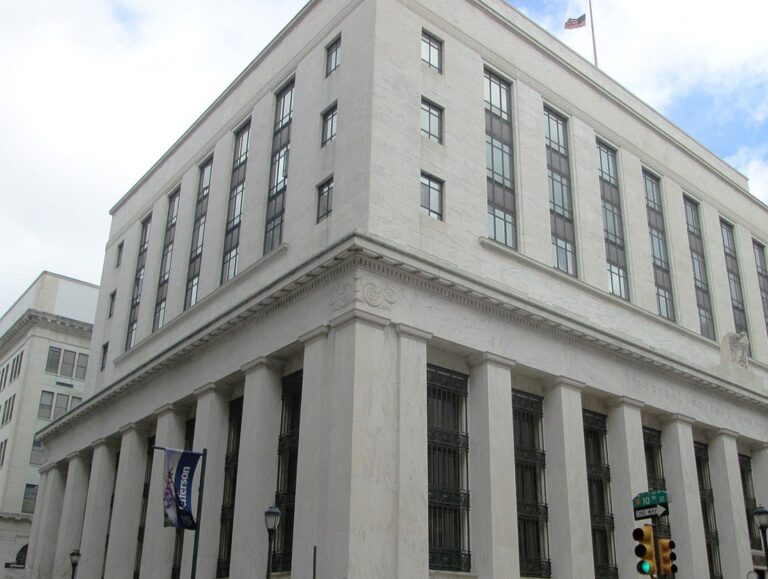The balance between bank reserves and the debt ceiling plays an important role in maintaining economic stability. When bank reserves decline, a chain of events can negatively affect financial markets and global economies.
With a deeper understanding of these economic areas, you’ll be better equipped to navigate the world of finance and make more informed decisions about your investments and money. Let’s dive in.
What Are Bank Reserves?
To better understand the financial system of our economy, it’s important to understand the fundamentals of bank reserves and how central banks manage them to promote economic growth.
Bank reserves are an important component of monetary policy and are used to control the money supply in the economy. They consist of funds held by commercial banks either in the form of currency or as deposits with central banks, such as the Federal Reserve. Bank reserves play an important role in maintaining financial stability and promoting economic growth.
The Fed sets reserve requirements for banks, which serve as a cap on how much money banks can lend. Banks must hold a certain amount of their deposits in reserve at all times to ensure that the bank can meet their obligations without having to borrow money from other financial institutions, even in the event of unexpected withdrawals.
Central banks help manage these reserves by making various monetary policy decisions. By adjusting interest rates, conducting open market operations, and setting reserve requirements, they can effectively influence the availability and cost of money in an economy. This, in turn, directly affects lending and borrowing by individuals, businesses, and governments.
For example, when the Fed raises or lowers interest rates, it affects the available money supply. When interest rates are lowered, it becomes cheaper for banks to borrow money from the Federal Reserve, encouraging them to lend more to their customers. On the other hand, higher interest rates make borrowing more expensive, which leads to less lending and less money on the market.
Their Relation To The Debt Ceiling
The debt ceiling serves as a fiscal benchmark that sets the maximum amount of debt that the United States can accumulate. This ceiling maintains fiscal responsibility and ensures the nation’s creditworthiness.
When bank reserves fall below the required level, it directly affects the ability of financial institutions to lend at optimal interest rates or to meet their customers’ withdrawal demands. Dwindling reserves place a significant burden on banks and result in reduced lending capacity. This restriction on lending can, in turn, limit overall business spending and investment, ultimately hurting economic growth.
The situation becomes even more unstable if dwindling bank reserves overlap with the approaching expiration of the debt ceiling. In these scenarios, the pressure on Treasury resources intensifies as it tries to maintain essential government activities while limiting borrowing. This creates a challenging fiscal environment that can exacerbate economic hardships and impair the government’s ability to respond effectively to financial crises.
Bank Reserves In Relation To The Debt Ceiling YOY
In recent years, we have observed a notable decline in bank reserves held at the Fed. This trend has coincided with an expected tightening of U.S. Treasury bonds due to the raising of the debt ceiling. The following table shows some key data and trends related to the decline in bank reserves and the debt ceiling.
| Year | Bank Reserves (Billions of USD) | Debt Ceiling (Trillions of USD) | Quantitative Easing (Billions of USD) |
| 2015 | 2,800 | 18.1 | 3,800 |
| 2016 | 2,600 | 19.8 | 0 (End of QE) |
| 2017 | 2,400 | 20.5 | 0 |
| 2018 | 1,900 | 21.7 | 0 |
| 2019 | 1,600 | 22.0 | 0 |
As shown in the table, the decline in bank reserves has been substantial in recent years, falling from $2.8 trillion in 2015 to $1.6 trillion in 2019, in parallel with a steady increase in the debt ceiling, which rose from $18.1 trillion in 2015 to $22.0 trillion in 2019.
In addition, quantitative easing ended in 2016, leading to a sharp decline in Treasury bond purchases by the Federal Reserve. These trends contribute to growing concerns about the negative impact of declining bank reserves on the debt ceiling and the broader economy.
The Negative Impact Of Declining Bank Reserves On The Debt Ceiling
The negative impact of declining bank reserves on the debt ceiling arises from the interconnectedness of the financial system and the broader economy. Below are some ways in which declining bank reserves affect the debt ceiling:
- If bank reserves decline, banks may have to restrict lending or raise interest rates to compensate for the lack of funds. This may lead to a decline in investment and spending.
- Slower economic growth can directly impact government revenues, as lower economic activity and consumer spending lead to lower tax revenues. This can make it more difficult for the government to manage the national debt.
- If the U.S. Treasury cannot meet its obligations due to a rigid debt ceiling, the country may face higher borrowing costs as investors demand higher interest rates to compensate for perceived risk. This can further strain government finances and make solving the debt ceiling problem even more difficult.
- Declining bank reserves may undermine investor confidence in the U.S. government’s ability to manage its finances. This loss of confidence can lead to a sell-off in government bonds, further exacerbating the problem.
- In the worst case, if the U.S. Treasury cannot raise the debt ceiling, the country faces a default. A default could have serious consequences for the economy, the financial markets, and society as a whole.
To maintain financial stability and prevent these negative effects, measures must be taken to counter the decline in bank reserves. By implementing effective measures and promoting coordination among key stakeholders, we can work toward a more resilient financial system and a healthier economy.
Strategies For Addressing Declining Bank Reserves
A multi-pronged approach is needed to address the economic downturn caused by dwindling bank reserves effectively. Some strategies that could be implemented include monetary policy adjustments, structural reforms, and coordination and communication among government agencies.
Monetary Policy Adjustments
Monetary policy adjustments refer to the various actions taken by central banks, such as the Federal Reserve, to influence the money supply, the availability of credit, and interest rates in the economy. These adjustments are intended to achieve certain macroeconomic goals, such as stable inflation, low unemployment, and sustained economic growth. The following are some of the possible policy adjustments:
- The Fed can lower interest rates to stimulate borrowing and consumption.
- The Fed can inject money into the system by purchasing Treasury bonds or other assets under quantitative easing.
- The Fed can change reserve requirements for banks so they can lend more money and spur economic growth.
- By implementing forward guidance, the Federal Reserve can clearly and transparently communicate its future monetary policy intentions, influence expectations, and promote financial market stability.
- The Federal Reserve can use open market operations, such as the purchase or sale of securities, to influence short-term interest rates and manage the money supply.
By using these monetary policy adjustment strategies, we can effectively counter the decline in bank reserves and maintain economic stability while addressing the challenges posed by the debt ceiling.
Structural Reforms
Structural reforms refer to far-reaching changes in economic policies, regulations, and institutions aimed at improving the efficiency and stability of a financial system. These reforms typically address the underlying problems of an economy and promote long-term growth and resilience by improving the underlying structure rather than offering short-term solutions. Here are some notable reform proposals that our government could put into action:
- Improve transparency and accountability in government borrowing to minimize the likelihood that the debt ceiling will be reached.
- Introduce measures that increase the availability of safe assets to alleviate banks’ liquidity constraints and strengthen their lending capacity.
- Strengthen supervision of financial institutions to curb excessive risk-taking that could trigger another financial crisis.
- Promote high-quality securitized assets to diversify banks’ funding sources and reduce reliance on traditional bank deposits.
- Develop contingency plans to address potential failures or other systemic risks that could arise if bank reserves continue to decline.
- Facilitate responsible fiscal policy by implementing measures to reduce government deficits and control the growth of government debt.
- Improve the efficiency of government spending by prioritizing investments in infrastructure, education, and research that can promote long-term economic growth.
By implementing these structural reforms, we can address the immediate challenges posed by the decline in bank reserves and create a more stable and resilient financial system that benefits everyone.
Coordination And Communication
Effective coordination and communication are proving to be necessary tools to address the challenges posed by declining bank reserves. The Federal Reserve must work closely with the Treasury to ensure adequate liquidity within the financial system.
One possible approach to achieving this coordination between the two could be to organize auctions of short-term securities to serve as a temporary stopgap until funds are restored. This approach has proven successful in previous cases, such as during the 2008 financial crisis, when the Treasury issued a series of short-term Treasury securities known as the Supplementary Financing Program (SFP). These measures helped stabilize financial markets and provided much-needed liquidity during a critical period.
Promoting effective coordination and communication can reduce uncertainty and increase the confidence of investors, businesses, citizens, and lawmakers in the nation’s economic well-being, even in the face of debt problems.
Invest In Precious Metals Today
If you’re looking for new ways to safeguard your assets against market fluctuations and inflation, precious metals such as gold and silver are one of the most popular options among investors worldwide.
Call us today at (877) 646-5347 to speak to our team about buying precious metals to store at home, or you can click here to get started by creating an account.







